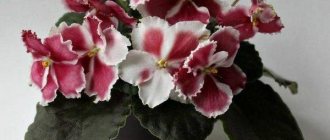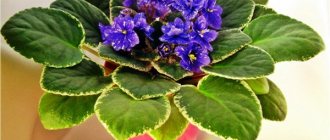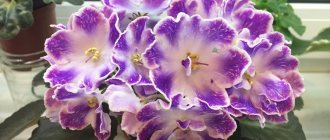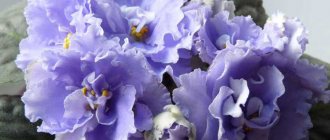In this article you will find a photo and description of the seedling of breeder Konstantin Morev Country of Crimson Clouds SM and read its detailed characteristics.
You will also learn how to properly care for this violet , what conditions are necessary for good growth and flowering. This information will help you avoid common mistakes that lead to disease and death of the plant.
Violet SM Country of Crimson Clouds (Seedling Morev)
The author of this unusual bright Saintpaulia with an intricate name is a breeder from Moscow Konstantin Morev . The name of the seedling appeared thanks to the work of the Strugatsky brothers “Land of Crimson Clouds”.
Meet the Uzambara violet Country of crimson clouds SM:
- family - Gesneriaceae;
- genus – Saintpaulia hybrid;
- flowers are very large, semi-double, gorgeous stars, warm raspberry-terracotta color. The tone towards the center becomes more saturated. The core is yellow. The edges of the petals are decorated with dark red dots. In a cool room, a greenish-bronze edging is formed. It produces many buds. Peduncles are strong, but fall down;
- leaves are dark green with a pink edging along the edge and pink-cream variegation. The socket is neat, smooth, standard. In starters, the variegation may be white, but it changes with age.
SM Country of Crimson Clouds.
Violet PT-Lady Hamilton (T. Pugacheva)
Creator of Saintpaulia
A delicate marshmallow violet with a bush of almost impeccably developed rosettes and considerable corollas in the form of balloon tutus of ballerinas appeared in the registers of violet growing after the completion of breeding experiments with variations of exotic Saintpaulias by the Kursk florist Tatyana Pugacheva.
The variety stands out among the endless range of varieties of exotic beauties of other breeders of our country with the abbreviation “PT” attached to the names of almost one hundred of its violets.
The master carries out the creation of new varieties from his own breeding line extremely meticulously, selecting the necessary varietal characteristics of specimens from a variety of options and paying special attention to checking them and then consolidating them.
Since the end of 2014, the variety has been taking part in various all-Russian and international flower exhibitions , where it is often awarded prizes and the favor of specialists from the panels of judges, and has also managed to earn the love of many flower growers.
Taxonomy
Saintpaulia genus, which is included in the Gesneriev family, which is breathtaking in its diversity of artistic images, the most powerful in terms of the large-scale volume of its varietal variety
The presented violet, in terms of the parameters and volume of the dimensions of the bush is included in the standard format section , and also belongs to the fancy varieties of Saintpaulias in terms of the color range of their corollas.
Photo and description of the variety
A varietal violet, when developed in a collection microclimate that is comfortable for it, after reaching an adult state, is distinguished by excellent volumetric and spatial symmetry of an almost impeccably formed bush with a dense texture filled with leaves.
But the achievement of this phase in the variety is somewhat slower than in other representatives of the genus, so it may take a significant period of time for the rosette to acquire sufficient compactness and configuration of the correct format.
According to the author's description, Saintpaulia must comply with standard parameters. But many flower growers who cultivate the variety note the development of quite large, although very cultivated, rosettes , which overestimate their size in comparison with the optimal format of standard representatives of the genus.
The growth of violets of this variety is characterized by significant independence - during the phase of active growth until the final format of the rosette is determined, specimens do not cause significant problems to gardeners.
IMPORTANT! Each Saintpaulia slowly and evenly distributes the plates of leaves that replenish the rosette in a neat order according to the number of tiers predetermined for the variety, providing a decorative picture of the plant.
The leaves of the violet are distinguished by their medium-sized dimensions, quilted texture of the fleecy surface, elongated heart-shaped shape with a smoothly tapered tip and structurally outlined venation pattern, which stands out against the background of the plate with a dense network of central and lateral veins. Along the edges of the leaves there are small, softly outlined denticles, creating a slightly wavy texture for the rosette.
The structure of the leaf plates has a fairly even format, but if the lighting conditions are disrupted, the edges of the leaves can rise upward, forming a “teaspoon” effect.
Lack of light also causes leaf petioles to elongate and leaves to move vertically. All this somewhat violates the decorative value of violets, but can be easily corrected by adjusting the conditions of maintenance.
INTERESTING! The color scheme of violet leaves is almost always in semi-dark shades of green. The very edge of the plates can be shaded with the thinnest braid of a brighter tone, and the bottom with a reddish coating.
Due to the measured development of the violet, the phase of its first budding occurs at a later date, compared to the classical one.
The flowering of Saintpaulia begins with the opening of single, but extremely large flowers and the formation of small bouquets, which in the further process of violet maturation acquire a voluminous format due to the large number of huge corollas opening simultaneously.
NOTABLE! Varietal violet is valued due to the size of its flowers, which even at the first opening have impressive dimensions and a double, less often semi-double, bud format.
The petals have a slight waviness of the contour edges, emphasized by abundant coarse-toothed fringe, which, combined with their significant amount in the corolla, visually enhances the volume and ethereal-airy radiance of the flowers and makes them look like the flying skirts of ballerinas.
The corollas of varietal violets are classified as “flower stars” . The tonal palette of flowers is a soft pink , sometimes reaching almost white, main background, on which fantasy splashes of denser shades of pinkish-lilac . The same tone is generously sprayed onto the fringe of the petals and creates a semblance of openwork braid on it.
Sports
Violet is seen in flowering sportive varieties, distinguished by the even pink color of the corollas with the absence of edge coating and fancy touches.
Home care
Seedling care is standard . By creating comfortable conditions for growth and development, the Land of Crimson Clouds will delight SM with abundant flowering.
Watering
An important factor for good plant development is proper watering. The water temperature should be room temperature.
There are several ways to determine the need for watering :
- Before the next watering, check the soil surface. It should dry to a depth of about 1 cm;
- more experienced gardeners weigh the pot on their hand and, based on its approximate weight, decide whether the plant needs watering.
Soil moisture is determined by its color - a dark shade indicates that there is enough moisture.
Important! At elevated air temperatures, violets are watered more often. And in low light conditions - less often.
Water the soil directly, pour water into a tray, and use the wick method. Do not allow water to get on the leaves and center of the rosette. Excess liquid from the pan is drained.
Feeding
Feed no more than once every 10 days with mineral fertilizers intended for flowering plants. Fertilizer is added to the water. The concentration of preparations for violets is halved.
Fertilizer for violets.
Lighting
Saintpaulias love natural light with a daylight duration of 11-13 hours . They are placed on the windowsill or racks near the windows. Do not allow direct sunlight to hit the plant, as the violet can get burned.
In poor lighting conditions, the flower stalks become too elongated and the flowers stop blooming. Excessive illumination is also harmful - leaves and flowers fade, turn pale, turn yellow, the rosette becomes denser, preventing the flowers from breaking through.
If there is a lack of sunlight, additional fluorescent lamps are used; if there is an excess, the windows are shaded with film or paper.
Temperature
Comfortable temperature for the growth and development of Saintpaulias is 18-24 °C :
- in a cooler room, Saintpaulia slows down its vital activity;
- at temperatures above 30 °C there is a threat of plant death.
Violet tolerates coolness better than heat . In hot weather, place plastic bottles with ice between pots of plants.
Humidity
For the best development of Saintpaulia, maintain a humidity of 50-55%. If this indicator is below normal, then growth and flowering slow down significantly. If the humidity is high, the plant may rot.
To maintain sufficient humidity, use humidifiers and leave open dishes with water. To reduce this indicator, fans and ventilation are used.
Drafts should not be allowed in the room with violets.
Priming
Soil for violets can be bought at a specialized store, but it is better to prepare it yourself. To do this, take forest soil, add peat, vermiculite, and biohumus.
You can make the soil yourself.
You can disinfect the soil using potassium permanganate. Add 2-3 drops of liquid potassium permanganate to 1 liter of water.
Attention! An important requirement for soil is lightness, looseness, breathability, pH 5.5-6.5, absence of lumps.
Hygiene
Violet hygiene involves removing dried, wilted leaves, peduncles and flowers. After this procedure, the plant looks neat and rejuvenated.
Constantly removing the lower leaves leads to the formation of a long stem, which spoils the appearance of Saintpaulia. To eliminate this deficiency, rejuvenation is performed:
- Cut off the upper part of the stem 1 cm long along with 5-6 leaves;
- Immerse it in water, leave it until roots form, plant it in the ground until it is completely rooted;
- Cover with film.
Reproduction
The seedling Country of Crimson Clouds SM reproduces well with children. For procreation, leaf cuttings, seeds, peduncles, and dividing the bush are also used.
Transfer
Violets are replanted every year, or preferably 2 times a year:
- Before the procedure, the soil is moistened so that the plant can be easily removed from the pot;
- Prepare the dishes with a layer of drainage and soil;
- Turn the violet over, carefully remove it and immerse it in a new container;
- They straighten the plant and fill all the voids with soil without compacting it, shed it.
Transfer.
Peruvian lily: plant care instructions
The instructions for caring for the plant are not very different from the instructions for caring for other herbaceous varieties. All you need to do:
- Regular weed removal.
- Regular moistening of the soil.
- Timely application of fertilizers.
- Prevention against parasites and diseases.
The most important thing is not to let the plant die in the winter season. Most varieties are dormant down to minus twenty degrees. Autumn care includes:
- Trimming the plant by five to seven centimeters.
- Creating a mulch layer.
Violet Peruvian lily: video
Features of flowering, growth and reproduction
Even novice flower growers can grow violet Country of Crimson Clouds SM at home. It is absolutely unpretentious and develops easily:
- The seedling reproduces well by stepsons and produces many children. The lateral sprout (baby) is carefully cut off with a blade at the base along with 2 pairs of leaves. They plant it in a peat tablet. After 3-4 weeks, they are transplanted into the ground along with the tablet. The varietal characteristics of violets are conveyed well;
- in about 5-6 weeks the baby grows. After 6-8 months, the baby turns into a starter. After 12 months, the violet can be called an adult plant and you can enjoy its first flowering;
- violet blooms in the Land of Crimson Clouds SM abundantly. Prefers cooler weather, tolerates heat less well. At high temperatures, flowers bloom reluctantly, petals fade in the bright sun, losing their original color;
- The peduncles are strong , but the peculiarity of the variety is that they fall . This does not interfere with the formation of a beautiful lush head of large bright flowers.
A special feature of the variety is its drooping flower stalks.
Ice Rose
“Ice Rose” is a variety that can decorate the collection of any amateur gardener.
Quite large double flowers with a corrugated edge against the background of dense bright green leaves look almost weightless. Distinctive features of the variety are:
- A wide rosette reaching a diameter of 4 cm. This point should definitely be taken into account when choosing a pot for violets.
- The ability to change the shade of flowers from flowering to flowering. From white with small splashes of lilac, the tone turns into crimson with a light border.
- Large sheet size. The length can reach 12-15 cm.
- With moderate lighting and fertile soil, up to 8 flowers can appear on one bush.
Reviews
Reviews of Saintpaulia Country of Crimson Clouds are mixed. Not everyone likes seedlings and considers them a “mistake” that has no right to exist. They indicate that there is not enough zest, that the violet looks gloomy. And yet, there are much more positive reviews.
Lyudmila. “I fell in love with the violet at first sight and it did not disappoint me: there are a lot of buds even in the first flowering, the flower stalks are strong, the flowers are huge and bright.”
Natalia. “I really like violet. It's just a pity that the flowers are falling. But what a neat rosette and variegated foliage suits her!”
Alexander. “I like that Saintpaulia does not require any special care. Completely unpretentious. It grows on wick watering and is easily propagated. Pleases with bright beautiful flowering and even variegated rosette of leaves.”
Birth of love
The “Birth of Love” variety, bred by breeder E. Korshunova, fully lives up to its name. The flowers are unusually delicate, airy, and the aroma is light and fresh.
The color of the petals smoothly transitions from white to light pink. The edge is framed by a wavy border. The inflorescences are arranged in a lush cap and can completely cover an unattractive, at first glance, rosette.
Villodene
If most violets acquire a special decorative effect only with the beginning of flowering, then “villaden”, thanks to the unusual color of the leaves, stands out even in the absence of ovaries.
Distinctive features of the variety:
- Wide, reaching a diameter of 45 cm, rosette;
- Simple pink or peach flowers with a wavy edge that may turn slightly green as temperatures drop;
- Large leaves of variegated, white-green colors.
“Villodene” does not bloom as profusely as other varieties, so it is grown exclusively for its decorative rosette.
Proper watering of red Saintpaulia
Violet LE-Summer Red prefers timely watering with soft warm water. Cold water has a detrimental effect on the root system of the plant and leads to a lack of flowering. It is advisable to use soft water, purified using household filters, or boiled and settled, to moisten Saintpaulia.
Interestingly, some gardeners recommend using hot water for irrigation, especially in the cold season. It warms the pot, nourishes the root system and gives the plant a healthy appearance.
The moisture schedule may vary depending on climatic conditions; it is advisable to focus on drying the soil and not water the plant more than 3 times a week.











